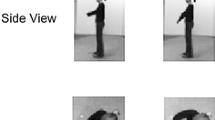Abstract
This paper presents a novel viewpoint selection criterion for active object recognition and pose estimation whose key advantage resides in its low computational cost with respect to current popular approaches in the literature. The proposed observation selection criterion associates high utility with observations that predictably facilitate distinction between pairs of competing hypotheses by a Bayesian classifier. Rigorous experimentation of the proposed approach was conducted on two case studies, involving synthetic and real data, respectively. The results show the proposed algorithm to perform better than a random navigation strategy in terms of the amount of data required for recognition while being much faster than a strategy based on mutual information, without compromising accuracy.
Similar content being viewed by others
References
Aloimonos, J., Weiss, I., and Bandyopadhyay, A. 1988. Active vision. International Journal of Computer Vision, 1(4):333–356.
Arbel, T. and Ferrie, F.P. 2001. Entropy-based gaze planning. Image and Vision Computing, 19:779–786.
Arbel, T. and Ferrie, F.P. 2001. On the sequential accumulation of evidence. International Journal of Computer Vision, 43(3):205–230.
Arbel, T. and Ferrie, F.P. 2002. Interactive visual dialog. Image and Vision Computing, 20:639–646.
Bajcsy, R. 1988. Active perception. Proceedings of the IEEE, 76(8):966–1005.
Borotschnig, H., Paletta, L., Prantl, M., and Pinz, A. 2000. Appearance-based active object recognition. Image and Vision Computing, 18:715–727.
Callari, F.G. and Ferrie, F.P. 2001. Active object recognition: Looking for differences. International Journal of Computer Vision, 43(3):189–204.
Chen, J.-H. and Chen, C.-S. 2004. Object recognition based on image sequences by using inter-feature-line consistencies. Pattern Recognition, 37:1913–1923.
Cover, T.M. and Thomas, J.A. 1991. Elements of Information Theory, Wiley.
Darrell, T. and Pentland, A. 1995. Active gesture recognition using learned visual attention. In Neural Information Processing Systems, vol. 8, pp. 858–864.
Denzler, J. and Brown, C.M. 2002. Information theoretic sensor data selection for active object recognition and state estimation. IEEE Transactions on Pattern Analysis and Machine Intelligence, 24(2):145–157.
Dickinson, S.J., Christensen, H.I., Tsotsos, J.K., and Olofsson, G. 1997. Active object recognition integrating attention and viewpoint control. Computer Vision and Image Understanding, 67(3):239–260.
Ertin, E. and Priddy, K.L. 2002. Reinforcement learning and design of nonparametric sequential decision networks. In Proceedings of the SPIE Conference on Applications and Science of Computational Intelligence IV.
Geman, D. and Jedynak, B. 2001. Model-based classification trees. IEEE Transactions on Information Theory, 47(3):1075–1082.
Glover, F. and Laguna, M. 1998. Tabu Search. Kluwer Academic Publishers.
Goldberger, J., Gordon, S., and Greenspan, H. 2003. An efficient image similarity measure based on approximations of KL-divergence between two Gaussian mixtures. In Proceedings of the 9th International Conference on Computer Vision, Nice, France, pp. 487–493.
Gremban, K.D. and Ikeuchi, K. 1994. Planning multiple observations for object recognition. International Journal of Computer Vision, 12(2):137–172.
Herbin, S. 1996. Recognizing 3D objects by generating random actions. In Proceedings of the IEEE Conference on Computer Vision and Pattern Recognition, San Francisco, CA, pp. 35–40,
Kaelbling, L.P., Littman, M.L., and Cassandra, A.R. 1998. Planning and acting in partially observable stochastic domains. Artificial Intelligence, 101:99–134.
Kovačič, S., Leonardis, A., and Pernuš, F. 1998. Planning sequences of views for 3-D object recognition and pose determination. Pattern Recognition, 31(10):1407–1417.
Laporte, C. 2004. A fast discriminant approach to active Bayesian visual recognition and pose estimation. Master’s thesis, McGill University, Montreal, Quebec, Canada.
Laporte, C., Brooks, R., and Arbel, T. 2004. A fast discriminant approach to active object recognition and pose estimation. In Proceedings of the 17th International Conference on Pattern Recognition, Cambridge, U.K, vol. 3, pp. 91–94,
MacKay, D.J.C. 1992. Bayesian interpolation. Neural Computation, 4(3):415–447.
MacKay, D.J.C. 1992. Information-based objective functions for active data selection. Neural Computation, 4(4):589–603.
Murase, H. and Nayar, S.K. 1995. Visual learning and recognition of 3-D objects from appearance. International Journal of Computer Vision, 14:5–24.
Paletta, L. and Pinz, A. 2000. Active object recognition by view integration and reinforcement learning. Robotics and Autonomous Systems, 31:71–86.
Paletta, L., Prantl, M., and Pinz, A. 2000. Learning temporal context in active object recognition using Bayesian analysis. In Proceedings of the 15th International Conference on Pattern Recognition, Barcelona, Spain, pp. 695–699.
Russel, S. and Norvig, P. 1995. Artificial Intelligence: A Modern Approach, Prentice-Hall.
Schiele, B. and Crowley, J.L. 1998. Transinformation for active object recognition. In Proceedings of the International Conference on Computer Vision, Bombay, India, pp. 249–254.
Seibert, M. and Waxman, A.M. 1992. Adaptive 3-D object recognition from multiple views. IEEE Transactions on Pattern Analysis and Machine Intelligence, 14(2):107–124.
Sipe, M.A. and Casasent, D. 2002. Feature space trajectory methods for active computer vision. IEEE Transactions on Pattern Analysis and Machine Intelligence, 24(12):1634–1643.
Sutton, R.S. and Barto, A.G. 1998. Reinforcement Learning: An Introduction. MIT Press: Cambridge, MA.
Vasconcelos, N. 2001. On the complexity of probabilistic image retrieval. In Proceedings of the 8th International Conference on Computer Vision. Vancouver, Canada.. pp. 400–407.
Zhou, X.S., Comaniciu, D., and Krishnan, A. 2003. Conditional feature sensitivity: A unifying view on active recognition and feature selection. In Proceedings of the 9th International Conference on Computer Vision, Nice, France, pp. 1502–1509.
Author information
Authors and Affiliations
Corresponding author
Rights and permissions
About this article
Cite this article
Laporte, C., Arbel, T. Efficient Discriminant Viewpoint Selection for Active Bayesian Recognition. Int J Comput Vision 68, 267–287 (2006). https://doi.org/10.1007/s11263-005-4436-9
Received:
Revised:
Accepted:
Published:
Issue Date:
DOI: https://doi.org/10.1007/s11263-005-4436-9




